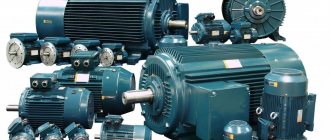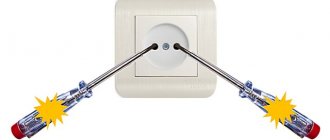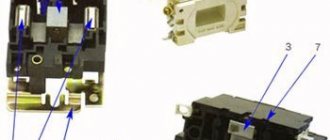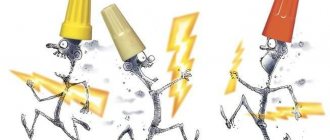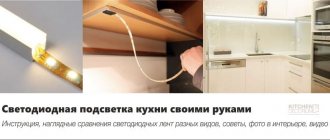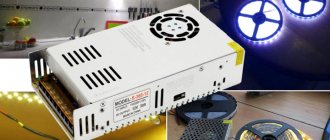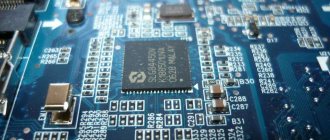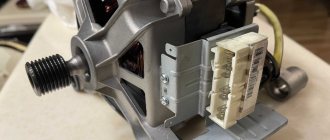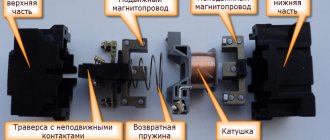Electric motors are quite complex mechanisms that are capable of developing high power, due to which they ensure the operation of many devices. The scope of their application is extensive - they can be found in a vacuum cleaner, meat grinder, and washing machine. But everything is not limited to domestic conditions, and these mechanisms can be part of industrial equipment, where they are capable of much greater functionality. At the same time, sooner or later, malfunctions of electric motors occur.
If in everyday life a breakdown is limited only to discomfort, then on an industrial scale this leads to forced interruptions in the operation of electrical equipment. And such delays in production are extremely undesirable, so it is necessary to promptly identify the cause of the malfunction and eliminate it as soon as possible.
Electric motor design
There is no point in going into details, so we will limit ourselves to a short course. From a design point of view, any electric motor consists of two main parts:
- Stator is a stationary part that is attached to the mechanism body.
- The rotor is the rotating part due to which the devices operate.
In this case, the rotor is located in the stator cavity and does not mechanically contact it in any way, but at the same time it can come into contact through bearings. When analyzing a fan motor or any other device for faults, the first thing to check is the ability of the rotor to rotate. To do this, the first step is to completely remove the voltage from the power circuit and only then can you manually rotate the rotor.
For an electric powertrain to operate, two important conditions are necessary. Firstly, its winding (multiphase electric motors have several of them) must be supplied with a rated voltage. Secondly, both the electrical and magnetic circuits must be in full working order.
Types of electrical machine repairs
To prevent malfunctions, maintenance and scheduled repairs of electrical equipment should be carried out according to the approved schedule.
Electrical machine repairs are divided into maintenance (MOT), current, medium and major repairs. The scope of work in each of these types of work is determined by the “Standard Regulations on Maintenance and Repair (MRO) of Electrical Equipment”.
Maintenance
This is to maintain equipment in working order between scheduled repairs. Carried out by maintenance and operational maintenance personnel.
Provides for the following types of work:
- inspection;
- heating check;
- wiping off dirt;
- insulation check;
- identifying faults and eliminating them.
It is carried out according to the approved schedule and during downtime - lunch break, adjustment, tool change.
Maintenance
Maintained in working condition until repaired. Produced on site or in a workshop. Includes:
- complex of maintenance works;
- replacement of failed components - bearings and couplings;
- adjustment and checking of alignment.
Medium renovation
For problems that cannot be eliminated during routine repairs, a medium repair is performed. This produces:
- complete disassembly;
- if necessary, replace bearings;
- repair of housing and shaft;
- impregnation of windings with varnish;
- insulation or replacement of leads
Medium repairs are carried out in specialized workshops and enterprises.
Electric motors operating on direct current
These mechanisms have a fairly wide range of uses:
- fans of computer devices;
- vehicle starters;
- powerful diesel stations;
- grain harvesters, etc.
The magnetic field of the stator of these mechanisms is created by two electromagnets, which are assembled on special cores (magnetic cores). Around them there are coils with windings.
The magnetic field of the moving element is formed by the current that passes through the brushes of the commutator unit along the winding laid in the grooves of the armature. We will definitely touch on the topic of electric motor rotor malfunction, but a little later.
Complete stator rewinding
To begin work, it is necessary to free the winding coils from the fastening elements; in the process, the connections between the coils and the phases are cut, and for a complete inspection, the craftsmen install the starter on a special tilter. The length and width of the groove are measured and the functionality is checked. During the process, the craftsmen advise making a template and preparing insulating material for further work.
The process of installing the sleeves and laying the belts requires time and care; it is carried out after winding the stator coils on a special machine and unpacking the coil.
AC motors
These mechanisms can be either asynchronous or synchronous. Some similarities can be identified between induction models and DC motors. However, there are design differences. The rotor of asynchronous power electrical installations is made in the form of a short-circuited winding (there is no direct current supply to it from the electrical installation). Popularly, this design received a rather sonorous name - “squirrel wheel”. In addition, in such engines there is a different principle of arrangement of stator turns.
In synchronous power units, the windings of the coils on the stator are located at the same offset angle to each other. Due to this, electromagnetic field lines are formed, which rotate at a certain speed.
The rotor electromagnet is located inside this field. Under the influence of the applied magnetic field, it also begins to move in accordance with the frequency synchronous with the rotation speed of the applied force.
Rotor rotation estimation
Troubleshooting an AC motor involves various manipulations of the rotor. Often the ability to assess the degree of rotation of this moving element is complicated by the connected drive. For example, the power unit of a vacuum cleaner can be unscrewed by hand without any problems. And in order to rotate the working shaft of the hammer drill, you need to make some effort. But if the shaft is connected to a worm gear, then in this case, due to the peculiarities of this mechanism, it will not be possible to turn it at all.
It is for this reason that rotor rotation is checked only when the drive is turned off. But what can make it difficult to rotate? There are several reasons for this:
- The sliding contact pads are worn out.
- The bearings are missing grease or the wrong compound has been used. In other words, ordinary grease, which is usually used to fill ball bearings, thickens at strong negative temperatures. This may cause the electrical mechanism to start poorly.
- The presence of dirt or foreign objects between the stator and rotor.
Typically, the cause of a motor bearing failure is not difficult to determine. The broken part begins to make noise, which is additionally accompanied by play. To identify this, it is enough to shake the rotor in a vertical or horizontal plane. You can also try moving the rotor in and out along its axis. It is worth considering that a slight backlash is the norm for most power unit models.
Checking the brushes
The commutator plates are essentially the contact connection of part of the continuous armature winding. Through this connection, electric current is supplied to the brushes. While the power unit is in good condition, a transient electrical resistance is formed in this unit. Fortunately, it is not capable of having any significant effect on the operation of the mechanism.
How to determine if an electric motor is faulty? For those power units that are subjected to heavy loads during operation, the collector plates usually become dirty. In addition, graphite dust can accumulate in the grooves, which negatively affects the insulating properties.
The brushes themselves are pressed against the plates under the influence of springs. During operation of the electric motor, the graphite is gradually worn away, the length of the brush rod is shortened, and the force created by the spring decreases. As a result, the contact pressure weakens, which leads to an increase in the transient electrical resistance. Because of this, the collector begins to spark.
Ultimately, this leads to increased wear on the brushes, including the copper commutator plates. In turn, everything ultimately ends in engine failure. For this reason, it is important to regularly check the brush assembly, carefully inspecting the cleanliness of the surfaces. When searching for the causes of an electric motor malfunction, one should also not forget about the performance of the graphite brushes themselves, including the operating conditions of the springs.
Detected dirt should be removed with a piece of soft cloth, pre-moistened in a solution of industrial alcohol. The spaces between the plates must be cleaned using blued wood made from hard, non-resinous wood. You can go over the brushes themselves with fine-grained sandpaper.
If potholes or burnt areas are found on the collector plates, the assembly itself undergoes mechanical treatment, including polishing, until all irregularities are eliminated.
The main reasons causing breakdowns of electric motors
After the electric motors are assembled in the factory, they are subjected to various tests. And upon completion, they are considered fully operational and delivered to the market or directly to the customer. Subsequently, all malfunctions that arise are detected during further operation of the power units.
Among the causes of the main malfunctions of electric motors can be attributed to violation of transportation conditions from the manufacturer to the destination. In most cases, failure can occur during the loading or unloading stage of electric motors. Also, not every company handles the transportation of cargo responsibly, in particular, not following recommendations regarding the transportation of electric motors.
Another reason is a violation of storage rules. As a result, the main components of power units are destroyed due to the effects of temperature changes, humidity levels and other external factors.
Repair of components and parts
Before starting work, it is mandatory to inspect the technological map for repairing an asynchronous motor. Thanks to preliminary diagnostics, the problem and specific malfunction are determined.
A plan is being drawn up to remove it. The main malfunctions include weakening of the pressing, fluffing of the teeth, heating of the core, burnout of individual sections, and deformation of the steel during fast operation. The repair procedure includes diagnosing the spacers and tightening the bolts.
To eliminate weakening of the pressing in the event of individual teeth breaking or falling out, some craftsmen recommend hammering and strengthening special wedges that will do the desired job and not slow down the electric machine. When the core heats up, craftsmen not only remove it, but also completely replace the insulation, since this affects the operation of the coupling bolts. If the insulation begins to break through on the steel winding, complete clearing and winding of new elements is done.
Electric motor malfunctions and ways to eliminate them
Among the large number of breakdowns, the most common cases can be identified:
- The armature does not rotate when the power supply is connected, which may be due to low current or its complete absence.
- The required rotation speed does not develop. Here the cause of the malfunction may be a worn bearing.
- Overheating of electric motors. In this case, there are quite a few reasons - from overloading the device to poor ventilation.
- There is a strong humming sound from the mechanism during operation, as well as the appearance of smoke. The turns of certain coils may be shorted.
- The mechanism vibrates strongly - caused by an imbalance in the fan wheel or other part of the power unit. This can be detected during a visual inspection.
- The shutdown button refuses to work. This usually happens when the contacts on the magnetic starter get stuck.
- Extraneous noise due to bearing overheating. Such a breakdown is usually caused by severe contamination of the part or its wear.
This is not the entire list of malfunctions of asynchronous electric motors (and others) that may arise during the operation of electric power plants. Only an experienced specialist can determine other damage. Let's look in more detail at some equally common faults.
Preparing the machine for repair
A machine that arrives for repair or inspection must be equipped with all necessary parts, cleaned of dirt, and the upper elements must be removed. This will allow you to quickly and efficiently carry out superficial diagnostics and find out the causes of problems.
To measure insulation resistance, a special device is used - a megohmmeter. To carry out a high-quality check of the windings, technicians recommend using a universal resistance bridge or special probes. When overhauling asynchronous motors, it is better to determine the temperature of individual accessible places using shelf-type alcohol thermometers, which are cylindrical in shape and small in size.
This will allow you to use the thermometer in hard-to-reach places and correctly determine the temperature. To avoid damage during inspection, it is recommended to wrap the thermometer reservoir with special foil - this will help press the device more tightly to the heated surface.
The bearing temperature can be much higher if it is damaged or lacks special lubricant. The results of the inspection must be recorded in a protocol or journal.
Uniform stator overheating
In some cases, the active steel of the stator of electric motors begins to overheat, although the load has rated parameters. In this case, heating can be uniform or uneven. In the first case, the reason may be the voltage, which is higher than the rated value, or it may be the fan. The cause of such a malfunction can be easily eliminated - to do this, you need to reduce the load or strengthen the fan motor.
When identifying motor faults, it is also important to pay attention to how the stator windings are connected. Usually it all depends on the value of the rated voltage:
- For low values, a delta connection is used.
- For higher voltages a star connection is provided.
In other words, for a “triangle” it is 220 V, and for a “star” it is 380 V. Otherwise, the power unit may be overloaded, which can lead to its overheating.
Uneven stator overheating
In case of uneven overheating, there are several reasons. This could be a breakdown in the stator winding or a short circuit to the housing. Because of this, the teeth not only burn out, but can also melt.
This can also be caused by shorting between some plates caused by burrs. In addition, it cannot be ruled out that the rotor touches the stator housing. In this case, troubleshooting the electric motor will be reduced to cutting out faulty elements and removing burrs. After this, it is necessary to isolate the sheets from each other using mica or special cardboard.
If there is too much damage, the active steel of the stator is re-mixed and all sheets are re-insulated. The stationary part itself is rewound.
To quickly determine why the electric motor failed and in which components the failure occurred, it is recommended that you familiarize yourself with the list of the most popular faults. Below are typical breakdowns, causes and ways to properly eliminate them.
Malfunction: The electric motor makes a loud noise when starting, does not pick up speed, or does not start at all.
Reason: Open circuit of the stator, open circuit of one of the phases (tip, cable, contactor), burnt out protective insert. Solution: Restore the power circuit, check and replace the fuse.
Cause: Broken stator winding. Solution: Rewind the stator.
Reason: Break in the phase rotor circuit (cable, rheostat, brushes). Solution: Restore the rotor chain.
Cause: Loss of contact between the rods and rings in the squirrel-cage rotor (smoke and sparks). Solution: Rotor repair.
Cause: Jamming of the motor shaft or drive. Solution: Clean the engine or its mechanism from possible contamination.
Cause: Low starting torque, which does not allow the rotor to gain speed. Solution: Replacement with a similar motor with a higher starting torque.
Cause: Star connection instead of triangle Solution: Check the correctness of the connection diagram, reconnect.
Malfunction: Strong heating in the plain bearings.
Cause: Lack or insufficient amount of lubrication. Solution: Lubricate the bearings properly.
Reason: The oil contains impurities and mechanical particles. Solution: Change the lubricant.
Reason: Wear of coupling half parts, ring defect, broken shaft journal, etc. Solution: Repair the mechanical part of the engine.
Fault: Strong heating in the rolling bearings.
Cause: Lack or insufficient supply of lubricant, excess lubricant. Solution: Lubricate the bearings properly, monitor for possible leaks, and remove excess grease.
Cause: Bearing defects, expressed by extraneous noise. Solution: Replace the bearing.
Malfunction: The motor housing becomes very hot during operation.
Reason: Poor performance of the forced cooling system. Solution: Cleaning channels and technological openings.
Cause: Ventilation ducts allowing cold air to pass through are clogged. Solution: Blow with compressed air.
Cause: Increased current load. Solution: Reduce the load or replace it with an electric motor of higher power.
Malfunction: Sparking during ED operation and appearance of smoke.
Cause: The rotor is in contact with the stator surface. Solution: Engine repair.
Cause: Incorrect operation in the protective or ballast system. Solution: Diagnostics of the protective or ballast system and elimination of defects.
Malfunction: Increased vibrations during ED operation.
Cause: Wear of connecting couplings Solution: Disconnect the couplings and check the ED without connecting to the mechanism.
Cause: The alignment of the engine and mechanism is disturbed. Solution: Check and tighten fasteners and frame mounts.
Cause: Bearing wear, rotor imbalance, mutual displacement of the rotor and stator positions. Solution: ED repair.
Malfunction: Fluctuations in the current consumption of the EM stator during its operation.
Cause: Poor connection in the circuit - for a wound rotor, for a squirrel cage rotor - poor connection between the rods and rings. Solution: ED repair (for large fluctuations - immediately, for small fluctuations - the sooner - the better).
Malfunction: Sparks from the commutator-brush assembly. Strong heating and burning of the corresponding fittings.
Cause: Brushes are not sanded well. Solution: Sand the brushes.
Cause: Insufficient clearance for free movement of brushes in brush holders. Solution: Set the permissible gap within 0.2-0.3 mm.
Cause: Contaminated slip rings or brushes. Solution: Clean up and eliminate the source of contamination.
Cause: The slip rings have grooves and irregularities. Solution: Grind and grind the rings.
Reason: Weak brush pressure. Solution: Adjust the pressing force.
Cause: There is no uniform distribution of current between the brushes. Solution: Adjust the pressing force of the brushes and their free movement in the brush holders, check the condition of the Traverse contact group, and assess the condition of the conductors.
Malfunction: The active steel of the stator overheats evenly over the entire surface.
Cause: Increased supply voltage. Solution: Organize additional cooling of the electric motor and reduce the mains voltage to the standard level.
Malfunction: Strong heating of the active steel of the stator in a separate place at idle speed at normal network voltage.
Cause: Local short circuit between individual active steel sheets. Solution: Clean and sand the area where the sheets come into contact, and coat them with dielectric varnish.
Cause: The insulation in the places where the active steel is tied is broken. Solution: Restore insulation in these areas.
Malfunction: The wound-rotor motor does not reach the nominal speed when loading.
Cause: Poor quality connection in the rotor slip ring solder. Solution: Check soldering reliability visually and with a “voltage drop test”.
Cause: Poor contact of the rotor winding with the slip ring. Solution: Check and restore current-carrying connections.
Cause: Weak connection in the brush assembly and the rotor short-circuit mechanism. Solution: Grind and adjust the pressing force of the brushes.
Reason: Weak connection of contact wires in the starting equipment. Solution: Restore the integrity and reliability of contacts in the relevant area.
Malfunction: A motor with a wound rotor starts with an open rotor circuit, and under load cannot reach the nominal mode.
Reason: short circuit in the armature winding, connecting clamps of the frontal connections. Solution: Insulate the contacting clamps, eliminate the short circuit and replace the damaged armature winding.
Reason: Short circuit of the rotor windings in two sections simultaneously. Solution: Eliminate the short circuit and replace the winding of the faulty coil.
Malfunction: The engine with a squirrel-cage rotor does not pick up the normal number of revolutions.
Reason: The thermal relay has worked, the fuses or circuit breaker have failed. Solution: Check and eliminate these faults.
Malfunction: When starting the electric motor, the electric arc covers the slip rings.
Cause: There is dust and dirt in the brush assembly or on the slip rings. Solution: Clean.
Reason: High humidity in the area where the ED is used. Solution: Apply an additional layer of dielectric or replace the ED with another suitable for operation under current conditions.
Cause: Break in the contact connections of the rheostat or rotor. Solution: Carry out diagnostics of all connections and eliminate faults.
It's all in the rotor
If the following characteristic symptoms occur, the cause of the rotor malfunction should be sought in poor-quality soldering of its circuit:
- rotor overheating;
- buzzing;
- braking;
- asymmetrical current readings in phases.
Before you begin to repair the rotor, you should examine how well the soldering of its windings was done. If necessary, it is worth re-soldering, the same should be done with those areas that cause concern.
There may also be cases when the malfunction of the electric motor is due to the fact that the rotor is motionless and open, although the three rings have the same voltage. In this case, the cause of the malfunction most likely lies in the rupture of the wires connecting the rotor to the starting rheostat. As a rule, this is due to wear of the liners, shifting of the bearing shields, due to which the rotor begins to be attracted to the stator. Rotor repair means replacing the liners, as well as adjusting the bearing shields.
In addition, the brushes and commutator may spark or heat up. This can happen for several reasons:
- the brushes have become unusable;
- incorrect installation of brushes;
- the dimensions of the brushes do not correspond to the dimensions of the holder cage;
- poor connection of brushes to fittings.
In this case, it is enough to precisely align the brushes with the holders.
Increased vibrations
From a technical point of view, such a phenomenon can also be considered a malfunction of the electric motor. Typically, strong vibrations occur due to unbalance of the rotor, coupling or pulley. This phenomenon can also be facilitated by inaccurate alignment of the device shafts and bending of the coupling halves.
The first step is to balance the rotor, for which you need to balance the coupling halves with pulleys. You also need to center the engine. Place the coupling half in the correct position, but to do this, you must first remove it. Find the point of poor connection or break, and then repair the damage.
Expert advice
Everything does not end with just installing an electric motor, which is confirmed by many experts. All necessary measures must be taken to extend the life of electric power plants.
In particular, the staff must:
- Provide protection for electric motors with special devices.
- Install a soft starter for the electric motor. This will increase the service life of not only the power unit, but also its drive.
- Install a thermal relay. With its help, you can avoid thermal overloads, which is very important for electric motors.
- Prevent moisture from entering the engine housing and its cavity. This way you can ensure its performance, since this factor negatively affects the internal components of the electric motor.
- Regular maintenance is required. This includes cleaning the engine itself from contaminants, lubricating bearings, and tightening contacts.
- Do not repair power electrical installations without proper experience and skills. It is better to entrust this work to specialists.
In addition, it is important to promptly detect a motor malfunction and eliminate it, since this affects the delay in production. And, as you know, it is worth its weight in gold, if not even more valuable.
Disassembling the machine
The craftsmen begin work by removing the upper casing, which covers the fan blades from dust and contaminants from the outside. The disassembly process must be carried out as carefully as possible to avoid hammer blows or great force. This may damage the motor parts and cause it to malfunction.
During the repair process of a three-phase asynchronous motor, the bearing caps and bearing shields are removed. At the time of disassembling the elements from the shields, marks must be applied to the body, according to which, when reassembling the machine, the shield is installed in the right place.
If the machine is small, then the rotor is removed from the stator manually. When the dimensions are large, the element is removed using special lifts, the process is carried out along the axis of the machine.
When it comes to removing bearings, there are several options. Elements of bushings or liners can be knocked out or protruded from special shields. Efforts cannot damage the main elements.
